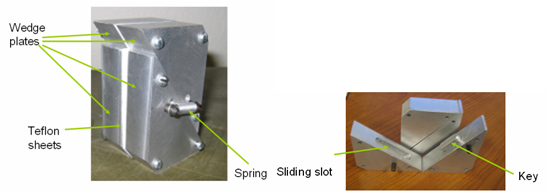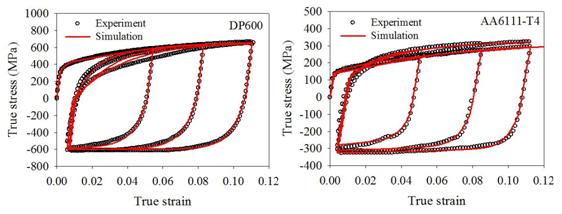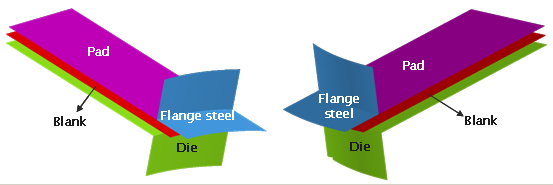The goal of this project is to provide an efficient tool to numerically predict the tendency of subtle surface distortion in line dies, particularly from the flanging process. The tool will be able to use the simulation data from commercial FEM software packages to predict distortions. Once implemented, this tool will help automotive engineers to change the design of tooling or blank geometry to limit surface distortions in the panel in a scientific way and therefore, shorten the design cycle significantly.
Since the surface distortion is likely to occur during the reverse loading (unloading) stage after the contact is removed, the accurate constitutive model should be utilized in the numerical prediction. Recently, in order to improve the prediction capability of reverse loading and springback behavior, the modified Chaboche type [1] combined isotropic- kinematic hardening law has been developed to describe the Bauschinger effect and the transient behavior [2]. Furthermore, to account for the permanent softening behavior during the reverse loading, the softening parameter has been introduced [3]. Also, in order to describe non-symmetric behavior during the reloading stage after the reverse loading, the non-symmetric reloading parameter has been newly introduced in this work.
While various constitutive models have been proposed, experimental investigation of thin sheet metals under the cyclic loading has become a challenging issue. For this, a new novel test fixture has been developed to use a regular tensile-compression machine (for example, MTS machine) [4]. A regular ASTM sub-size dogbone specimen is clamped between the two Teflon sheets in the test apparatus. The novel wedge design with springs loaded allows blocks to freely move in the vertical direction while providing the normal support to the entire length of the specimen during the tension-compression cycle.
Double-wedge in-plane compression test device
Calculated and measured hardening behaviors of base materials in tension-compression tests with considering softening and non-symmetric reloading behavior for DP600 stee and AA6111-T4 sheet
FEM simulation models for stretch and shrink flanging
References
-
J.L. Chaboche, 1986, “Time-independent Constitutive Theories for Cyclic Plasticity”, Int. J. Plasticity, Vol.2, pp.149-188.
-
K. Chung, M.-G. Lee, D. Kim, C. Kim, M.L. Wenner and F. Barlat, 2005, “Spring-back Evaluation of Automotive Sheets Based on Isotropic-kinematic Hardening Laws and Non-quadratic Anisotropic Yield Functions Part I: Theory and Formulation”, Int. J. Plasticity, Vol.21, pp.861-882.
-
W. Lee, J. Kim, D. Kim, C. Kim, M.L. Wenner and K. Chung, 2007, “Numerical Sheet Forming Simulation of Friction Stir Welded TWB Automotive Sheets”, Int. J. Plasticity, Submitted
-
H.S. Cheng, W. Lee, J. Cao, M. Seniw and H.P. Wang, “Experimental and Numerical Investigation of Kinematic Hardening Behavior in Sheet Metals”, ESAFORM 2007, Accepted.



